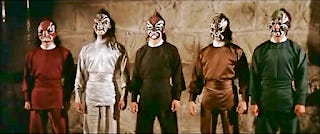A couple of weeks ago I finally found the headspace to start reviewing my failed Martian novel.
Normally I’m pretty unsentimental about my work and can move through manuscripts with cold-blooded vigor. Not with this book. I could only stand to look at it five six pages at a time before I would either clamp up in frustration or lose my patience, but at least I wasn’t suffering strong urges to throw my computer across the room. I was flipping through the pages, slow and steady, and that was a positive sign.
That was about the extent of the positives. There was so much wrong with the manuscript. The structure was shapeless and cumbrous, and the protagonist too wearingly prolix, a grotesque mix of Saleem Sinai and Colin Robinson. The worldbuilding (this was one of those books that lives or dies by its worldbuilding) wasn’t bad, per se, perfectly fine for a D&D sourcebook -- but was wrong for a novel. My nerdiness had put together some intriguing stuff, a Firstborns vs the Wildborn conflict, an implacable posthuman Sracn, but there was simply too much lore, delivered in huge haphazard gouts that ended up smothering the diegesis.
Not exactly a rousing diagnosis and yet, these were deficiencies well within the range of fixable. Given enough time and enough, well, gumption. The manuscript might never end up a a work of beauty, but fractured books are some of the best books. If you’re going to find massive fails in your manuscript, these are the ones you want to find – cracks that are easy to identify, that can be isolated and, with enough pencil-miles, corrected.
There are, however, other fails that can befall a manuscript, fails that often glide past the most scrupulous of editors in spite of their systemic nature. These are the kind of complex fails you pray you don’t find in your manuscripts. The shadow-fails I’m talking about soak into the fundamental processes of a book, like a quiet radiation, and because they become so deeply entrenched, fixes become difficult. If these fails are too encompassing it often becomes necessary to destroy the manuscript in order to save the book.
And naturally this was exactly the fail that I found in the second half of my Martian manuscript.
In truth, I should have spotted this shit the moment I started the second half of the book – but that’s the nature of these things – they are shadowy; they elude.
Why should I have caught it early? Because it’s one of the venoms that can kill a work of fiction, even a great work of fiction, dead. And if you don’t catch it and it is pervasive, it will most definitely kill. Worse yet, often the writer won’t even know their work is dead; something about the occulting nature of this particular narrative venom highjacks the writer’s mind, cordyceps style, convincing them that the text is alive and well and, none the wiser, many are the writers who will keep investing time on their dead book, tinkering forever and ever, on characters, on plot, on voice, or sending the manuscript to this agent or that who never accepts but never offers clear reasons why they find the book objectionable either.
This is what was afflicting the latter half of my book, one of Five Deadly Venoms of Fiction.
What is this terrible malady called?




